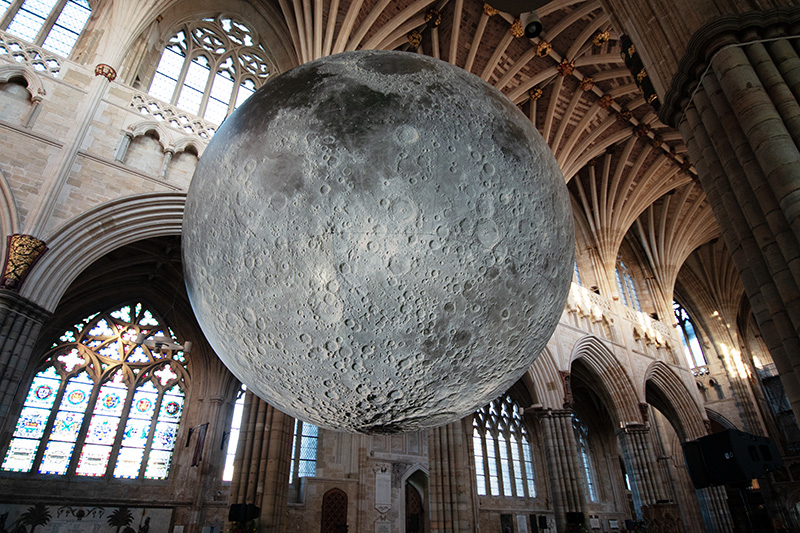
By Anca, Youth Volunteer at Exeter Cathedral
Why You Should See It
As a student, I often look for interesting cultural experiences that don’t break the bank. When I heard that Luke Jerram’s Museum of the Moon had arrived at Exeter Cathedral, I knew I had to see it for myself. Having now visited, I can say that it’s a fascinating blend of art, science, and history, and if you haven’t been yet, I’d highly recommend going before it leaves on 1 March.
What is Museum of the Moon?
Created by British artist Luke Jerram, Museum of the Moon is a seven-meter-wide sculpture of the Moon, featuring incredibly detailed high-resolution NASA imagery. Every crater, ridge, and shadow are mapped onto its surface, allowing visitors to see the Moon as if they were observing it from space. The installation has been displayed in locations across the world, from Beijing and New York to Glastonbury Festival, and now it’s here in Exeter for a limited time.
Accompanying the artwork is a carefully curated soundscape by BAFTA-winning composer Dan Jones, which adds to the immersive atmosphere. The combination of visual and auditory elements makes the experience feel more than just an art piece—it becomes a moment of reflection on our connection to the Moon and the wider universe.
Why Exeter Cathedral is the Perfect Setting
Exeter Cathedral, one of the finest examples of architecture in England, offers a stunning backdrop for the glowing lunar installation. The contrast between the ancient stone walls, the towering vaulted ceiling, and the soft illumination of the Moon creates a unique and striking visual experience.
Historically, cathedrals have been places of wonder, contemplation, and knowledge – much like the Moon itself, which has inspired centuries of art, literature, and scientific discovery. The installation seems at home in this space, encouraging visitors to look up and think beyond the everyday. The combination of historic craftsmanship and modern artistic interpretation makes this exhibition particularly special.
A Moment to Pause and Reflect
One of the most striking aspects of the Museum of the Moon is its atmosphere. Unlike a traditional museum exhibit, where you might read plaques and move from piece to piece, this installation invites you to stop, look, and absorb. The Cathedral’s quiet ambiance, combined with the gentle glow of the Moon and its accompanying soundscape, creates a calm, almost meditative experience.
Many people who have visited the installation in different locations have described it as peaceful and thought-provoking. Standing beneath the Moon, you can’t help but feel a sense of scale—not just of the artwork itself, but of the universe. It’s a reminder of how small we are in comparison to the vastness of space.
The Science Behind the Art
Beyond its artistic appeal, Museum of the Moon also serves as an educational experience. The Moon has played a crucial role in human history, influencing tides, calendars, and even mythology. The detailed NASA imagery used in the sculpture highlights real lunar features, allowing visitors to recognize elements such as the Tycho Crater, the Lunar Maria (dark plains formed by volcanic activity), and the Apollo landing sites.
If you’ve ever wondered about the surface of the Moon or how it compares to what we see from Earth, this installation offers a rare chance to see it in a visually striking, large-scale form.
Why You Should Visit Before 1 March
If you haven’t seen Museum of the Moon yet, now is the time to go. The exhibition is only at Exeter Cathedral until 1 March, and after that, it will move on to its next destination. It’s a unique opportunity to see a globally renowned artwork in a breathtaking historical setting.
Whether you’re interested in art, astronomy, history, or simply looking for a different experience, this installation is well worth your time. It’s one of those rare exhibits that appeals to people of all ages and backgrounds, offering everyone a chance to experience the Moon in a new way.
Final Thoughts
As a student, I often look for experiences that are both educational and visually impactful, and Museum of the Moon delivers on both fronts. It’s an installation that encourages curiosity, inspires reflection, and provides a moment of calm in a busy world.
So, if you’re in Exeter, take an hour to visit the Cathedral and see the Moon up close before it’s gone. Whether you go alone or with friends, it’s an experience that stays with you long after you leave.
🌙✨ See you under the moon! ✨🌙